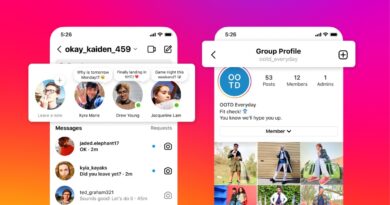I actually had fun at Fatboy Slim’s metaverse rave
I stood outside a 50s truck stop diner and gas station under a dark, dusky sky. A bright neon sign that said Norm’s Drive In illuminated the space. Behind a psychedelic school bus parked in the dirt lot, monstrous limbs with huge eyeballs, long lashes and smiley faces for irises extended upwards. Little aliens ran around me, and I fell into a swirling vortex that made me want to vomit. Familiar dance electronic beats played in my ears.
From there I was taken through a series of even more outlandish settings. A Mad Max-style parade of cars, a dance floor inside a human skull, a nauseating roller coaster ride, a table back at the diner where I was tiny and rode cockroaches around glasses of milkshake. Then I was skydiving in the clouds while gold-clad dancers did acrobatics before landing in a desert where a digital replica of iconic British DJ Fatboy Slim did his set in front of a tripped-up version of Mount Rushmore. Instead of the founding fathers, the carved faces were Che Guevara, Greta Thunberg, Camille Yarbrough and Grandmaster Flash.
This was not a dream. It was a 45-minute Fatboy Slim concert in virtual reality. Only during this concert, there would be no digital replicas of venues, no feeling of togetherness with the crowd and, certainly, for me alone in my bedroom on a Thursday morning in New Zealand, no dancing.
“We don’t want to be hung up on reality,” Norman Cook, AKA Fatboy Slim, told me after the concert. “The whole point of the metaverse is that things can happen there that can’t happen in real life. So we took that idea and said we’d make it a fantasy gig where you would go in your dreams.”
This fantasy gig was created and hosted by Irish metaverse startup Engage. When the company first invited me to join this concert, I was skeptical to the point of eye rolling, but still curious. Was this just a marketing ploy for Fatboy Slim, who was on tour at the time? How much of a hand would Cook actually have in the ideation of this event? Why does Engage, a company that describes itself as a “business-focused metaverse platform” want to throw a virtual rave?
Turns out Cook was indeed involved in and passionate about the project (more on that later). It was also definitely a marketing ploy, but not so much for the DJ — rather, for Engage.
“We built a platform for enterprise and education, and the majority of our user base are the same age as me,” said Dave Whelan, 42, CEO and co-founder of Engage. “We wanted to host a concert to get people interested in the platform and show off its capabilities, but also to attract the right type of client to the platform. We don’t want a lot of 12- and 14-year-old kids. We want professionals, and Fatboy Slim would have been one of those artists that they’d have grown up with.”
Part of Engage’s strategy to show off its capabilities was to create the antithesis of an analog concert, something unconstrained by the laws of nature or physics, or even the laws of gigs. A real-life gig performed live in one venue. This one had a recording of Fatboy Slim present at every strange scene, and it intentionally moved from place to place that leaned into the intangible.
“It doesn’t necessarily have a linear narrative or actually mean anything,” said Cook. “It could be a dream. It could be an acid trip.”
Whelan agreed that getting kooky is the whole point of the metaverse.
“If you try to replicate the real world, you’re always going to lose. The real world is fantastic,” Whelan told TechCrunch. “Give people experiences they can’t get anywhere else. So that’s why the concert started off kind of like a concert, and then it just progressively got crazier and crazier.”
A gig to show off Engage’s abilities
The Kia dealership in the metaverse is part of the Kia Sportage campaign. Visitors can explore the space, talk to dealers, schedule test drives and then follow the blue portal back to Engage Link. Image Credits: Rebecca Bellan/Engage
Today, the Engage app is used by a range of corporate and education clients, from KPMG and Kia to Stanford and Oxford Universities. The work Engage does with Kia is how I originally connected with the company. They showed me around a Kia dealership in the metaverse, which was built as part of the Kia Sportage campaign.
Whelan said companies like KPMG have been using Engage to see how it feels replacing Zoom meetings and in-person offsites with virtual boardrooms and immersive experiences. They’re also meeting up in Engage to network and talk about the metaverse, something that Whelan hopes to foster so that Engage can become “the LinkedIn of the metaverse.”
Universities are using Engage both to learn more about VR and the metaverse, and to access immersive courses. For example, I sat in on an Oxford University lecture set in a replica of the university’s Bodleian Library about Venus that included hovering models of planets rotating in a virtual library.
It all sounds very exciting, but like any metaverse-related concept, Engage might be putting the cart before the horse. The company is building out worlds and content, taking a bet that professionals, for example, will actually want to buy a headset and wear it for metaverse hangs and virtual networking events. One could look to Zoom as an example of the world getting comfortable engaging in a digital space, but Zoom didn’t have the same friction as Engage and other VR apps. In other words, Zoom is downloaded to an existing laptop or PC — it doesn’t require you to invest in a whole new piece of hardware.
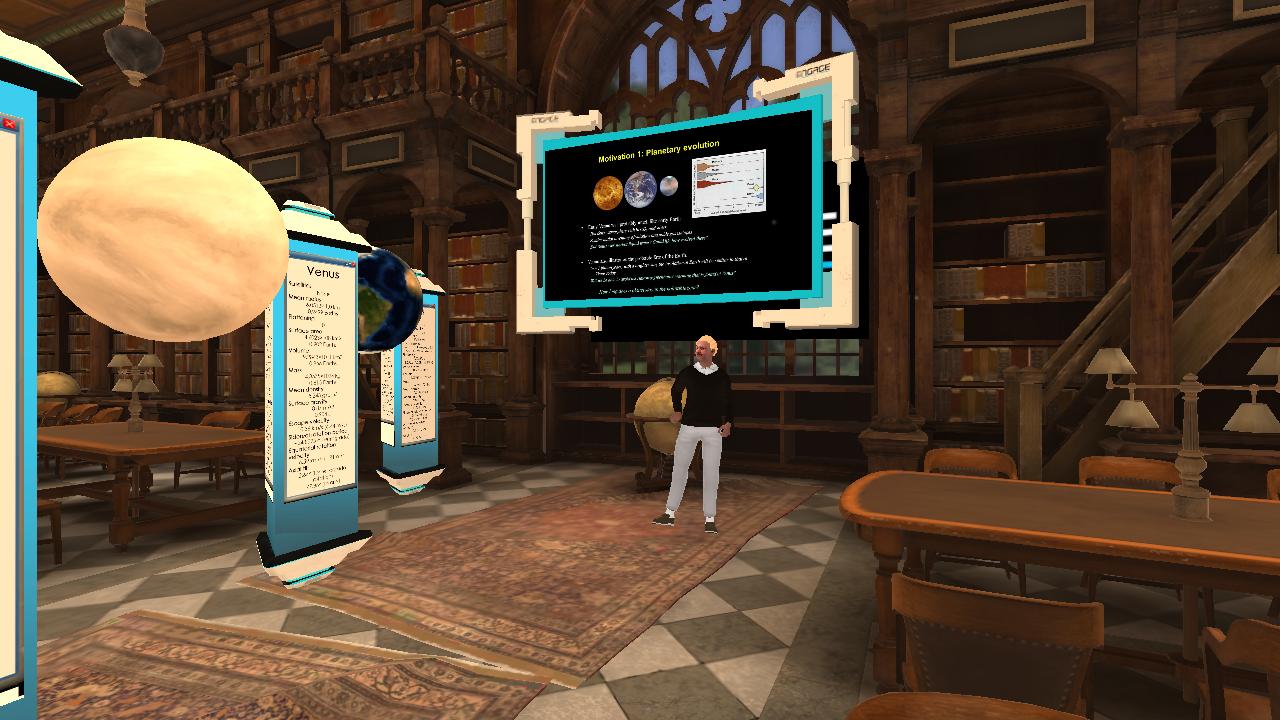
“Exploring Venus” lecture with Professor Colin Wilson at a digital replica of the University of Oxford’s Bodleian Library. Image Credits: Rebecca Bellan/Engage
Sales of VR headsets in the U.S. actually declined 2% year-over-year in 2022, according to data from NPD Group, and that is already coming from a lean starting place. This year is expected to be another slow one in the VR market due to a weak economy and inflation, which means people won’t want to spend money on non-essential purchases like VR headsets. And in this stage of capitalism where only constant growth makes a product successful, stagnation and decline are death knells. Numerous false starts from companies like Google and Samsung have also soured many early adopters.
Meta’s Oculus Pro, which is wireless and geared toward professionals, launched last year at around $1,500, but the price has since dropped to $1,000. The Oculus Quest 2 is also wireless and more affordable at around $400. Sony’s latest VR headset launched in February at $550, but it requires a PlayStation 5 to power it.
Apple has been long rumored to be coming out with a VR headset, and many expect the company to announce a new product at its annual developer conference in June. Apple’s loyal fanbase and reputation as a leader in consumer technology could validate the market and turn the mainstream toward the world of extended reality. However, just as many will hold out on buying the new PlayStation 5 until there’s a game compelling enough to incentivize them; there will need to be a reason for people, not just gamers, to immerse themselves before they shell out the cash on a headset.
Engage hopes that in the next 10 years, its core product Link could be that reason for businesses, educational institutions and, eventually, creators.
Engage Link: The metaverse in a suit
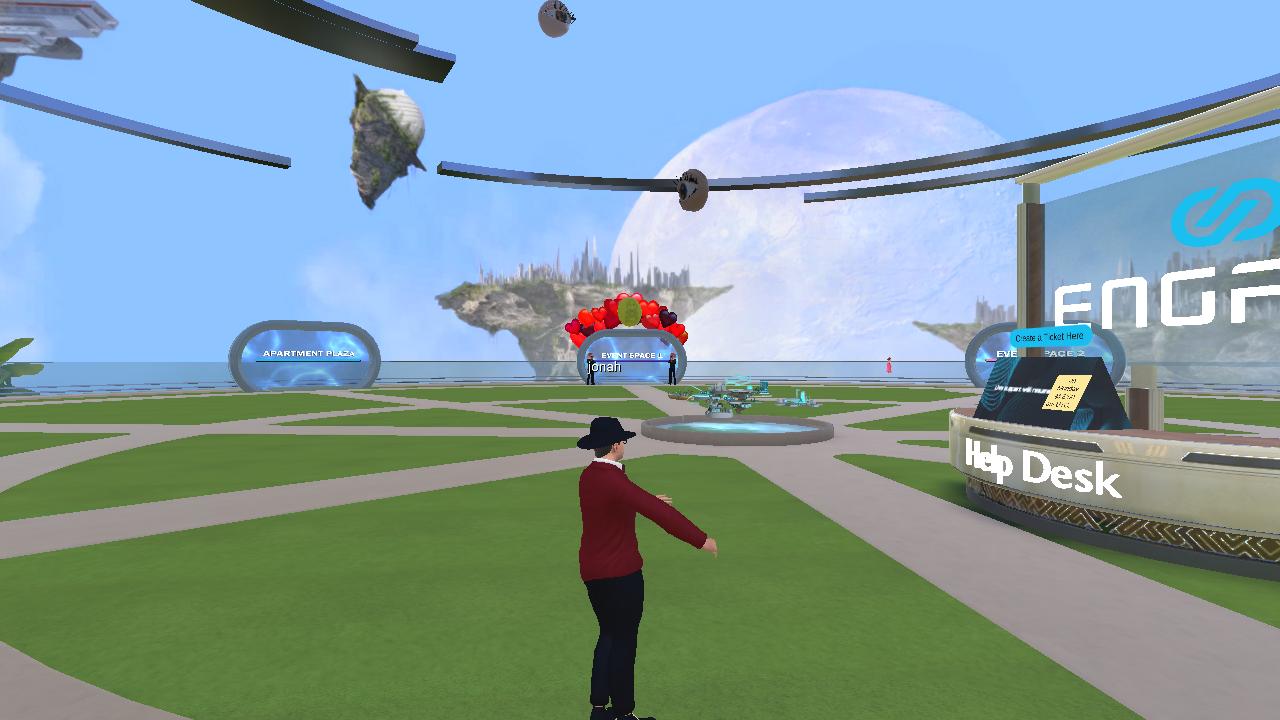
Engage’s Central Plaza is a landing pad for all of the other portals, and it’s where you can occasionally find live assistance at the help desk. Image Credits: Rebecca Bellan/Engage
The main product on the Engage app is Link, a series of “linked, persistent plazas” or virtual worlds that are always on, waiting for someone to explore them. Whelan says to think of Link like the homepage of a website, only way more immersive.
The separate “plazas” are all their own floating islands that serve a specific purpose. The Central Plaza, for example, is basically just a landing spot where you can access all the others, like the Education Plaza, the Apartment Plaza, the Creative Plaza, Template Valley and Tutorial Island. There is also live support there during the hours of 9 am to 1 am Irish Standard Time Monday to Friday, but Whelan hopes to have someone there 24/7 in the future.
I tried a few times to catch the live support, and when I finally did, it was anticlimactic. At first I was excited to see another person, not just a random floating avatar, in the space after days of exploring the virtual ghost town alone. I asked him where he was based, if he wore the headset at all times or if he got a ping when someone showed up at the help desk, and what kinds of things he could help me with. The man, bless him, was nervous to be questioned so, a feeling that was clearly exacerbated when I told him I was a journalist. He politely told me to contact Engage for answers to my questions.
Whelan says Engage’s user base is 60% education clients and 40% enterprise, but enterprise clients make up 70% of the company’s revenue. The Enterprise Plaza, therefore, is more developed than other plazas, and it’s where Whelan hopes to see his dream of Engage as the LinkedIn of the metaverse turned to virtual reality.
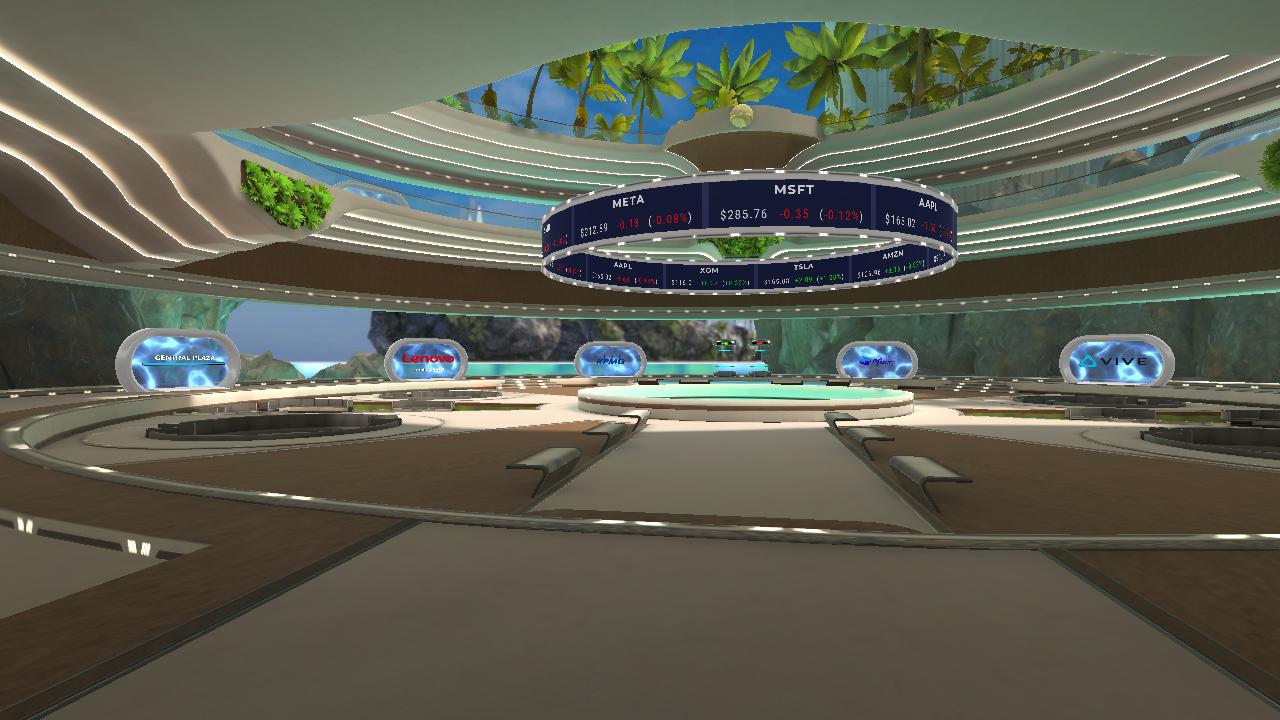
The Enterprise Plaza in Engage Link leads to portals built for clients like Kia, KPMG and Lenovo. Image Credits: Rebecca Bellan/Engage
How that’ll actually work in practice is beyond me, partially because it requires multiple people to be in the digital space at the same time. LinkedIn works because people can comment on a post or message someone whenever they happen to see it, so it’ll be interesting to see how Engage hopes to use the Enterprise Plaza to usher in a new way of interaction.
The space looks like an airy billionaire’s lair, a circular two-floor structure with rocky walls, plenty of round conversation pits and palm trees up above. Upon arrival into the plaza, I could hear some kind of elevator music, but also the faint sound of TV news. As I walked closer to the center, where a floating screen rotated with live stock prices for tech companies like Apple, Microsoft, Nvidia and Google, the voices got louder and I soon noticed that another screen hovered on the second floor playing Bloomberg Live.
All around the space are watery portals to different company hubs. In fact, in each plaza, the same shimmering portals exist to take you to new worlds. As you get closer to them, you can start to see what’s inside. For example, Pfizer’s shows a lab and Kia’s shows its dealership.
Companies like KPMG, HTC and Lenovo have begun using Engage mainly for training and connecting with each other remotely. Often enterprise clients will start in their virtual board room, and then they’ll go enjoy immersive experiences together, such as traveling to the surface of the moon or doing karaoke together.
Because universities are another core customer base of Engage’s, the Education Plaza is also well developed. The virtual space portrays an outside plaza, with stairs in all directions that take you to portals to different universities, like Oxford and Stanford, and educational companies, like Victory XR and Optima Ed.

The Education Plaza leads to worlds created by and for universities like Oxford and Stanford, as well as immersive learning like Victory XR and Optima Ed. Image Credits: Rebecca Bellan/Engage
Whelan says Meta has funded 10 “metaversities” on the platform, allowing thousands of students around the world to explore both on VR headsets and on mobile phones and tablets.
Jeremy Bailenson, a professor at Stanford University and founding director of the school’s Virtual Human Interaction Lab who studies the psychology of augmented and virtual reality, says Engage is his platform of choice for teaching his students about VR, in VR.
“We’re partnering with them because I think they’re the best to work with,” Bailenson told me, noting that he had tried a range of other platforms like Microsoft’s AltSpace and Meta Horizons and found Engage’s technological development to be superior. “One of the hardest parts about VR is content…It’s easy to find demos that last a minute or two, like an anatomy demo, but how do you fill up a couple of hours of people being together in VR?”
Some of the class assignments have included attending a guided meditation in outer space, creating performances with different avatars and building unique scenes using Engage’s in-platform tools.
Indeed, I also found that one of the cool things about exploring Engage is just how much content there is, how many worlds there are. Engage says there are around 800 private so-called MetaWorlds owned by the company’s 180+ clients. About 50 of those worlds are accessible to the public via Link.
Fatboy Slim’s world, for example, is available to the public to explore today, and it includes six unique MetaWorlds to create the whole experience: The Diner, the Road Trip, Inside Norm’s Head, the Giant Diner, SkyDiving and Mount Ravemore.
It is strange, however, how few people there are in Link. The handful of times I’ve been in there, I have found myself traipsing about alone, like I’m trespassing on private property after hours.
The space might start filling up, though, once Engage makes it even easier to build content and worlds, which might lower the barrier of entry for newbie metaverse users. The company is currently testing an AI named Athena, powered by ChatGPT, to be a front of house assistant.
Athena can “help you with a lot of different tasks in Engage,” according to a video demo. “I can open menus, draw images and create sticky notes; play and control videos; change my voice or gender; load or create objects and IFXs; recenter your headset; adjust audio levels and start and stop recordings.”
“The demo that we’re working towards is the Holodeck demo,” Whelan said, referencing Star Trek’s holographic environment simulator. “You should be able to walk into a metaverse platform which is a complete blank canvas and say, ‘Athena, make a location with six chairs. I want a window. I want a door. I want it to be nighttime outside. I want you to police this location, and here are the watch words. If you hear these words, warn the user that if they repeat these words, they will be banned from this session.”
This, he says, is to help ensure that Engage and other metaverse platforms prevent hate speech, usually from “12-year-olds who will go in there and absolutely troll the crap out of everybody, which we’ve seen on many platforms.”
Riding out the metaverse volatility
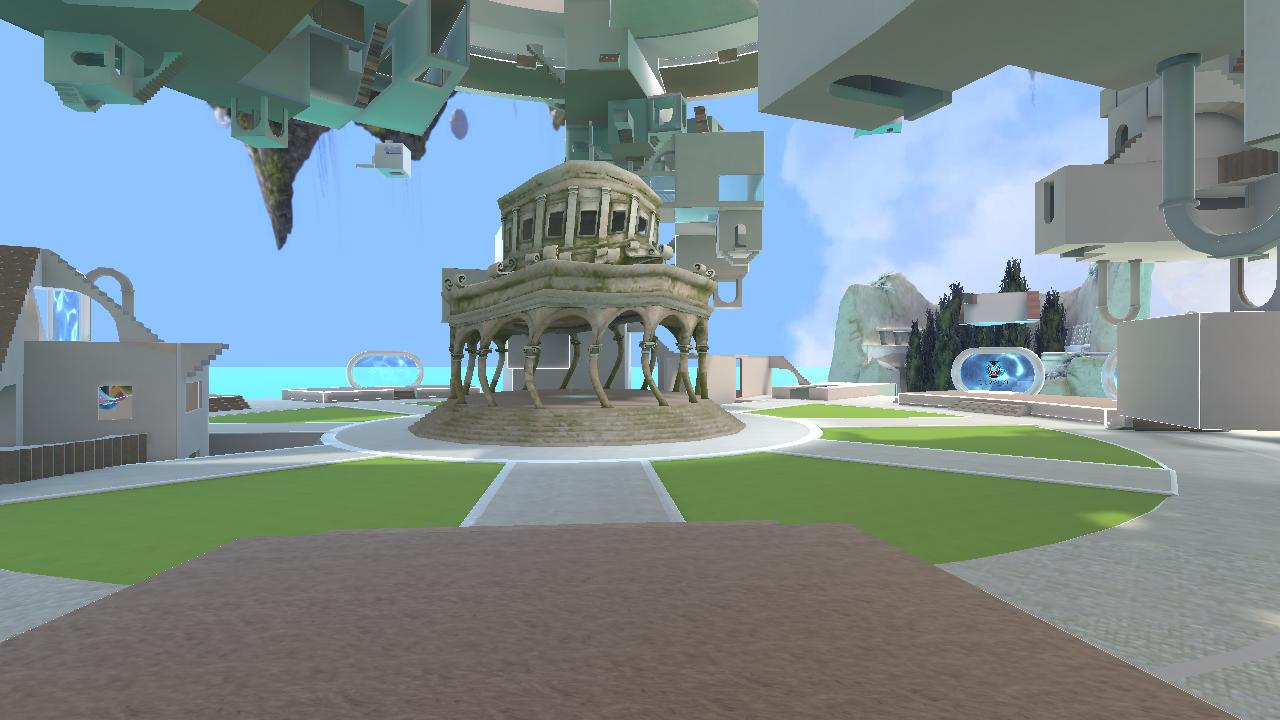
Designed and curated by immersive artists and engineers, the Creative Plaza provides an opportunity to explore unique metaworlds and attend art exhibitions. Image Credits: Rebecca Bellan/Engage
Whelan and his wife Sandra founded Engage XR Holdings in 2014, using a €1,000 loan from Whelan’s sister. Under the studio name Immersive VR Education, the company built and shipped the popular Apollo 11 VR and Titanic VR experiences, using Kickstarter campaigns to fund the projects that ended up bringing in millions in revenue, according to Whelan.
In 2018, the company decided to list on the London Stock Exchange, where it raised $7 million to continue to fund Engage. When the pandemic hit, Engage pivoted from focusing mainly on education clients to including business customers. Taiwanese electronics giant HTC asked the company to build it a virtual Vive Ecosystem Conference in early 2020, and then invested about $3 million in Engage.
This year, Engage raised another $10 million, money that it will use to hire more sales, business development and aftercare support employees. This, Whelan says, is a sign that the company is reaching maturity. Engage isn’t profitable yet, but it hopes to get to break-even by late next year. The company generated $4.2 million in 2022, doubling its revenues from the previous year, and expects similar growth year-over-year in 2023.
On the LSX, Engage is trading at £3.30 and has a market cap of £17.32 million, which Whelan says is partly due to London in particular and Europe in general giving out much lower valuations than in the U.S.
“We’ve had a completely crazy journey compared to a lot of companies in the U.S. where VCs go, ‘Oh, you’re awesome. There’s $50 million. Go spend it in the next year and a half and come back to me when you’re worth a billion dollars,’” said Whelan.
By contrast, Engage has learned to grow lean and sustainably. The company only chooses projects where it can win and make money, according to Whelan, and it charges clients not only for the finished product, but also for research and development.
“We’re not like, Hey we’re making cool shit and maybe somebody will buy it at the end. That’s not the way we work.”
That business philosophy might help Engage weather the volatility of the metaverse industry.
In 2021, when Mark Zuckerberg announced Facebook would be rebranded to Meta, and that the company would be a “metaverse-first” company, the tech world collectively raised an eyebrow. Meta had already spent billions on developing Horizon Worlds, the company’s social VR platform, and so far, the endeavor has been loss-generating. And worse, people aren’t even interested in using the platform.
Toward the end of last year, Meta recorded about 200,000 monthly active users, which is lower than the 500,000 MAUs the company had been aiming for, according to internal documents viewed by The Wall Street Journal. Those documents also showed that most users didn’t return to Horizon after the first month on the platform. Only 9% of the worlds are visited by at least 50 people, and most aren’t visited at all, according to the report.
Other big companies with stakes in the metaverse have taken steps back in recent months. Disney, for example, recently cut its metaverse team as part of a wave of employee reductions. Microsoft has also cut its Altspace, HoloLens and mixed reality teams. However, the company did say it would focus on Microsoft Mesh, which brings VR experiences to businesses.
Whelan says he’s not worried about the unpredictability. Since Engage is used to running lean, it has plenty of runway to make it through the next few years.
“I think with Meta especially, I think Mark Zuckerberg has the perception at the moment of being pretty uncool,” said Whelan. “He went out with his message about the metaverse two years ago and I think it was probably a little bit too much too soon. But I think when we look back in 10, 15 years, a lot of what he said will actually come to pass, and it’ll be people like Mark that made it happen.”
More concerts in the metaverse
While Engage is geared toward helping businesses and students explore the metaverse, the company said it expects to continue running concerts in the future, and to charge for them, thus bringing in another revenue stream.
The Fatboy Slim concert, for example, cost Engage about $200,000 to make, which Whelan says is much cheaper than the average VR studio. A team of three worked on the concert for about six months, but Whelan reckons Engage could do it in three or four months today with two dedicated people.
The Fatboy Slim concert was offered for free and globally in six time zones. I’m told 2,500 people registered for the actual event, and they came from all over — from the U.K. and the U.S. to Australia, the Netherlands and Japan. Whelan said Engage received a ton of requests to join after registration closed.
For his part, Fatboy Slim, AKA Norman Cook, thinks VR could bring about the new era of music videos, rather than the future of concerts.
“It’s a bit disconnected in VR and that’s the thing that’s missing, is that feeling of connectivity. It’s always gonna be a little bit detached,” said Cook. “That’s the one thing you can’t download the experience of.”
When the pandemic first hit and everyone was in lockdown, Cook did a different VR show for the Glastonbury Festival with Shangri-La, one of the festival’s after-hours areas. He said it was a true recreation of the Shangri-La stage. You could even wander around to the toilets.
“It was a faithful reproduction, trying to recreate the concert experience, which was interesting but kind of limited,” said Cook.
In the course of building the concert with Engage, Cook said the team tried to bring some of that real-world concert experience to the show by laying crowd noises over the music soundtrack. Cook says it “actually made things worse,” like you’re in a fake reality that’s trying to be real rather than in an alternate reality.
If musicians were to explore the use of VR for immersive music videos, “they could take you so much further than you can with a two-dimensional world,” said Cook.
Music videos became popular in the 1980s in large part because they allowed artists to illustrate their songs and bring them to life. In recent years, visual albums like Beyonce’s Lemonade have inspired wonder and escapism, expanding the role that music creates.
“My music isn’t really storytelling, and it’s not very highbrow. It’s just a load of scratchy noises to turn you on, repeated memes that take you somewhere,” said Cook. “If you multiply what I do by the imagination of someone like Radiohead or Lady Gaga, it could really be a beautiful thing. It would be like going to a movie where you’re just so immersed in all the action of it, and mixing that 3D world with a song that already takes you somewhere emotionally in the first place.”
I actually had fun at Fatboy Slim’s metaverse rave by Rebecca Bellan originally published on TechCrunch




